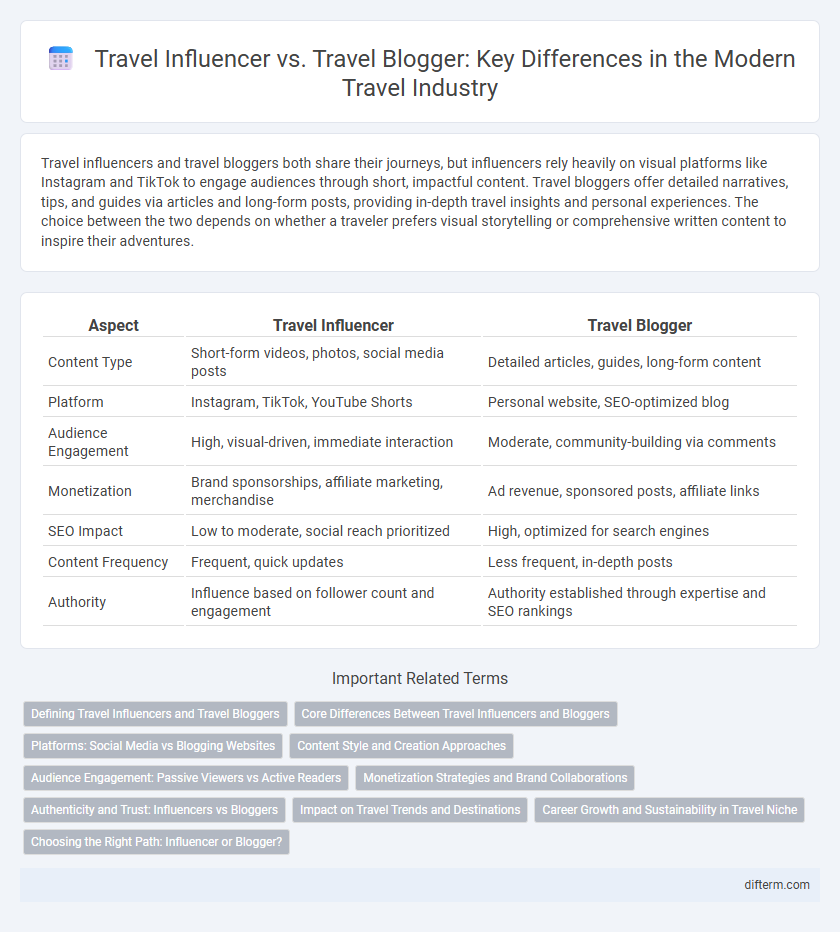Travel influencers and travel bloggers both share their journeys, but influencers rely heavily on visual platforms like Instagram and TikTok to engage audiences through short, impactful content. Travel bloggers offer detailed narratives, tips, and guides via articles and long-form posts, providing in-depth travel insights and personal experiences. The choice between the two depends on whether a traveler prefers visual storytelling or comprehensive written content to inspire their adventures.
Table of Comparison
| Aspect | Travel Influencer | Travel Blogger |
|---|---|---|
| Content Type | Short-form videos, photos, social media posts | Detailed articles, guides, long-form content |
| Platform | Instagram, TikTok, YouTube Shorts | Personal website, SEO-optimized blog |
| Audience Engagement | High, visual-driven, immediate interaction | Moderate, community-building via comments |
| Monetization | Brand sponsorships, affiliate marketing, merchandise | Ad revenue, sponsored posts, affiliate links |
| SEO Impact | Low to moderate, social reach prioritized | High, optimized for search engines |
| Content Frequency | Frequent, quick updates | Less frequent, in-depth posts |
| Authority | Influence based on follower count and engagement | Authority established through expertise and SEO rankings |
Defining Travel Influencers and Travel Bloggers
Travel influencers primarily leverage social media platforms such as Instagram and TikTok to share visually compelling content, engaging large audiences through real-time experiences and personal recommendations. Travel bloggers focus on detailed storytelling through written content on websites or blogs, offering in-depth travel guides, tips, and narratives that optimize search engine visibility. Both entities serve as trusted sources of travel inspiration, but influencers prioritize visual engagement while bloggers emphasize comprehensive, keyword-rich content.
Core Differences Between Travel Influencers and Bloggers
Travel influencers primarily leverage social media platforms to create engaging, visual content that drives immediate audience interaction and brand partnerships. Travel bloggers focus on in-depth storytelling, comprehensive guides, and SEO-optimized articles to attract organic search traffic and build long-term readership. The core difference lies in influencers' emphasis on quick, high-impact engagement versus bloggers' deeper, content-rich narratives that enhance website authority and user loyalty.
Platforms: Social Media vs Blogging Websites
Travel influencers primarily leverage social media platforms such as Instagram, TikTok, and YouTube to engage audiences with visually-driven content and real-time updates. Travel bloggers focus on blogging websites and platforms like WordPress or Medium, offering in-depth travel guides, personal experiences, and SEO-optimized articles. Both utilize different digital channels to target their audiences, with influencers emphasizing short-form content and bloggers providing detailed, long-form narratives.
Content Style and Creation Approaches
Travel influencers prioritize visually engaging content on platforms like Instagram and TikTok, often using short-form videos and stories to create authentic, real-time experiences. Travel bloggers emphasize detailed, long-form written content on personal websites or blogs, providing comprehensive guides, tips, and narratives that enhance reader engagement through SEO strategies. Influencers rely on dynamic, spontaneous posts to showcase lifestyle and culture, while bloggers focus on in-depth research and storytelling to build authority and trust.
Audience Engagement: Passive Viewers vs Active Readers
Travel influencers often attract passive viewers who engage primarily through visual content like photos and videos on platforms such as Instagram and TikTok, resulting in quick, widespread impressions. In contrast, travel bloggers cultivate active readers who delve into detailed blog posts, offering in-depth insights and personalized narratives that encourage comments and meaningful interactions. Audience engagement for influencers tends to be immediate and visually driven, while bloggers benefit from sustained attention and richer reader involvement.
Monetization Strategies and Brand Collaborations
Travel influencers capitalize on social media platforms like Instagram and TikTok to monetize through sponsored posts, affiliate marketing, and exclusive brand partnerships that leverage visual storytelling. Travel bloggers generate income primarily via ad revenue, sponsored content, and SEO-driven affiliate links embedded within their detailed travel guides and blog posts. Both focus on brand collaborations, but influencers emphasize direct engagement and short-term campaigns, while bloggers build long-term relationships through in-depth content and audience trust.
Authenticity and Trust: Influencers vs Bloggers
Travel influencers build authenticity through real-time, engaging multimedia content that fosters immediate trust and personal connection with followers. Travel bloggers establish trust by providing detailed, well-researched narratives and comprehensive guides that demonstrate expertise and reliability over time. Both roles cultivate authenticity, but influencers rely on dynamic interaction, while bloggers depend on in-depth, informative storytelling.
Impact on Travel Trends and Destinations
Travel influencers drive immediate engagement through visually captivating content shared on platforms like Instagram and TikTok, often sparking rapid shifts in travel trends and popularizing emerging destinations. Travel bloggers provide in-depth, narrative-rich experiences via detailed articles and guides, offering comprehensive insights that influence long-term travel planning and sustainable tourism growth. Both play pivotal roles in shaping traveler behavior, with influencers fueling instant demand and bloggers fostering informed and mindful travel decisions.
Career Growth and Sustainability in Travel Niche
Travel influencers often experience rapid career growth by leveraging social media platforms to engage large audiences and collaborate with brands, while travel bloggers build sustainable careers through in-depth content creation and SEO-driven websites that generate consistent organic traffic. The travel niche rewards influencers who excel in visual storytelling and trend responsiveness, whereas bloggers benefit from developing authority and trust in long-form travel guides and reviews. Both career paths require adaptability to evolving digital trends to maintain relevance and income stability in the competitive travel industry.
Choosing the Right Path: Influencer or Blogger?
Travel influencers leverage visual storytelling on platforms like Instagram and TikTok to engage audiences through authentic experiences and real-time updates, driving brand collaborations and sponsored content. Travel bloggers create in-depth, SEO-optimized articles on personal websites, providing detailed guides, narratives, and tips that build long-term audience trust and organic traffic. Choosing between influencer and blogger depends on your strength in multimedia engagement versus long-form content creation and your goals for audience interaction and monetization.
Travel influencer vs Travel blogger Infographic

 difterm.com
difterm.com